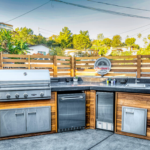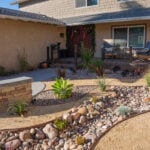Your backyard is not the only thing your outdoor area is; it’s an extension of your house, a haven where you can relax, unwind, and re-establish a connection with nature. A well-planned landscaping may transform your outside area into a mesmerizing haven, whether you have a large garden or a little patio. In this thorough book, we’ll dive into the foundations of landscape design, going over important ideas, methods, and pointers to assist you in turning your outside area into a gorgeous retreat.
Understanding Landscape Design:
Planting flowers and arranging plants is not the only aspect of landscape design. It takes a comprehensive approach to designing outdoor spaces that are both visually beautiful and useful. The main components of landscape design include layout, terrain, flora, hardscape features, and the overall mood you want to create. All of these parts must be carefully considered.
Assessing Outdoor Space:
Do a comprehensive assessment of your outdoor space before starting any landscaping projects. Keep an eye out for its dimensions, form, current characteristics, and any inherent qualities like drainage patterns, soil composition, and exposure to sunshine. Comprehending these variables will steer your design choices and enable you to optimize your outside area to the fullest.
Goals and Style:
Since each outdoor area is different, the landscape design you choose should showcase your lifestyle and particular tastes. Give your objectives for the area some thought. Which would you prefer—a utilitarian space for outdoor activities, a colorful garden for entertaining, or a calm haven for relaxation? Think about your chosen style as well, whether it’s formal, informal, modern, classic, or somewhere in between. The general appearance and atmosphere of your outdoor space will depend on the style you’ve selected.
Design Principles:
It’s time to dive into the landscape design concepts and practices that can help you realize your vision after you have a firm grasp of your outside area and design objectives.
Balance and Symmetry:
Harmony and aesthetic appeal are produced when balance and symmetry are achieved in landscape design. Balance can be attained via symmetrical arrangements, in which the elements are equally spaced on both sides of a central axis, or asymmetrical arrangements, in which the elements are balanced according to their mass and visual weight.
Scale and Proportion:
To establish a unified and well-proportioned design, take into account the size and arrangement of different components in your outdoor area. While smaller areas call for more delicate and correctly proportioned pieces to prevent overwhelming the space, bigger spaces may allow larger plants, trees, and hardscape structures.
Unity and Cohesion:
Your landscape design’s cohesive element, which gives it a sense of flow and consistency, is called unity. To make connections between various items in your outdoor environment, select a unifying theme, color scheme, or design pattern. Repetition of materials, colors, textures, and forms may promote cohesion and create an aesthetically beautiful and harmonious setting.
Focal Points and Hierarchy:
To attract attention and provide visual appeal, use focus points in your landscape design. Natural features such as a sculpture, a water feature, an impressive architectural aspect, or a specimen tree can serve as focal points. Prioritizing focus points and directing the viewer’s attention around the landscape are made easier by creating a hierarchy of objects within your outdoor area.
Functionality and Accessibility:
Make sure your outside area is accessible and useful by thinking about its practical features. Establish obvious paths and transitions between the various spaces you designate for eating, relaxing, gardening, or leisure. Add components to improve comfort and utility, such as seats, lighting, and shade structures.
Implementing Landscape Elements:
It’s time to start incorporating different aspects into your outside area now that you have a firm grasp of the concepts and methods of landscape design.
Plant Selection and Placement:
The foundation of every landscape design, plants provide your outdoor space vibrancy, color, and texture. Taking into account elements like sun exposure, soil moisture, and care needs, choose a wide variety of plants that flourish in your environment and growth circumstances. To provide depth and perspective, arrange plants in layers, placing larger specimens in the rear and lesser ones at the front.
Hardscape Features:
Your outdoor space gains structure and clarity with hardscape features including patios, walkways, walls, and buildings. Whether it’s concrete, brick, wood, or natural stone, choose materials that go well with the architecture of your house and the surrounding area. To establish boundaries, create useful spaces, and enhance the visual appeal of your outdoor space, carefully integrate hardscape elements.
Water Features:
Your outdoor space will feel more peaceful and serene with the addition of water elements like waterfalls, ponds, and fountains. When selecting a water feature for your landscape design, take into account its size and style to make sure it blends in with the overall look. To add drama and atmosphere, include water elements in major focal areas or as stand-alone attractions.
Lighting Design:
Your outdoor space is made more beautiful and safer by the addition of outdoor lighting. Which also extends its use into the evening. Use ambient, task, and accent lighting in combination to establish the atmosphere, provide depth, and draw attention to important details. To enhance convenience and flexibility, choose for energy-efficient LED lights and contemplate lighting control options like dimmers, timers, and sensors.
Maintenance and Sustainability:
For your outside area to continue looking its best once your landscape design is finished, regular care is necessary. Reduce chemical inputs, save water, and enhance biodiversity by putting sustainable techniques into practice. To keep plants at their best, regularly trim them, get rid of weeds, and keep an eye on watering systems. To lessen the environmental effect of your outdoor area. You can also think about using drought-tolerant species, native plants, and low-maintenance landscaping techniques.
Transformative Landscape Design
The beauty, usefulness, and value of your home may all be greatly increased. Transforming your outside area via landscape design is a satisfying project. You may construct an enticing outdoor refuge that expresses your own style and serves as a haven for pleasure and relaxation. By knowing the fundamentals, methods, and components of landscape design. Use this comprehensive guide as a road map to realize the full potential of your outdoor area. Hence, whether you’re beginning from scratch or rejuvenating an existing landscape.







